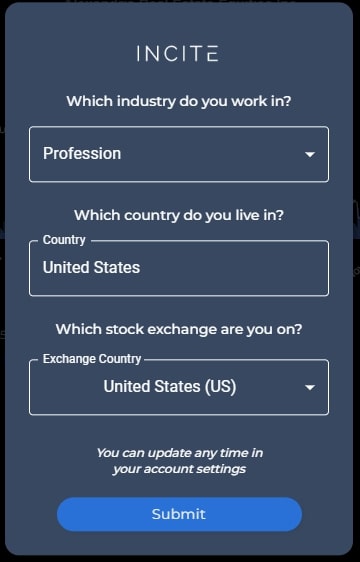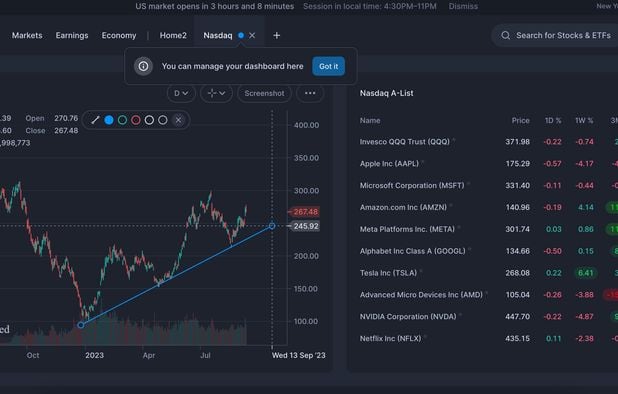The User Interfaces (UI) and the User Experiences (UX) of AI-powered stock trading platforms is crucial to their usability, efficiency overall satisfaction, and overall success. An undesigned interface can affect your decision-making process even if you have robust AI models. These are the top 10 tips for assessing the UI/UX of these platforms:
1. The user-friendliness and the user-friendlyness of the product are assessed
Navigation: Make it easy to navigate the platform including menus, workflows and buttons.
Learning curve: Find out how quickly users new to the platform can learn and operate an application without requiring any extensive training.
Consistency - Examine the patterns of design across all platforms to ensure uniformity (e.g. button colors styles, colors).
2. Make sure you check for customizability.
Dashboard customization: See if dashboards can be customized to display data, charts and metrics that are relevant for the user.
Layout flexibility: The platform must allow users to change the layout, size, or move widgets.
Themes: Find out whether your platform supports dark or light mode or any other visual preferences.
3. Examine the data Visualization
Chart quality: Ensure the platform provides high-quality, interactive charts (e.g., candlestick charts, line charts) with zoom and pan functions.
Visual clarity Make sure that all data is presented in a clear manner, including labels, legends and tips-offs.
Real-time updates: Check if visualizations change in real time to reflect market trends.
4. Test for Reactivity and Speed
Time to load: Make sure that the platform loads quickly even when working with large data sets or complex calculation.
Performance in real-time You must ensure that the platform is able to handle data feeds immediately without delays or lags.
Cross-device compatibility: Make sure that the platform is compatible with all devices including mobile, desktop and tablet.
5. Evaluate Accessibility
Look through the mobile application to see if it offers all the features that you require to trade on the go.
Keyboard shortcuts: Make sure the platform supports keyboard shortcuts to the most powerful users.
Accessibility features - Check that the application is in compliance with accessibility standards.
6. Examine Search and Filtering Functionality
Search performance: Ensure that the platform allows users a quick search of stocks, indices or other assets.
Advanced filters: Determine if there are any filters that you can apply to your results.
Saved searches. Verify the platform's ability to let users save frequently-used search terms or filters.
7. Make sure you are aware of alerts and notifications.
Alarms that can be customized: Make sure users can set up notifications for specific conditions.
Notification delivery - Verify whether alerts are delivered by multiple channels.
Timing - Ensure that alerts are generated quickly and precisely.
8. Evaluate Integration with Other Tools
Integration with brokers: The platform should be linked to your brokerage account so that trades can be made effortlessly.
API access - Check to see whether APIs are accessible to advanced users looking to build customized workflows or other tools.
Third-party integrations : Determine whether the platform is compatible with other software, like Excel, Google Sheets or trading bots.
9. Assessment Help and Support Features
Onboarding Tutorials: Check if your platform offers tutorials or guides for new users.
Help center. Make sure that the platform comes with an extensive help center.
Customer support: Check if there is a responsive customer support (e.g. live chat, email, or phone).
10. Test Overall User Experience
Feedback from the user review and testimonials of research conducted to determine the overall satisfaction level with the UI/UX.
Trial period - Try out the platform for free trial and see how it works.
Error handling: Examine how the platform handles errors or edge situations (e.g. incorrect inputs or server downtime).
Bonus Tips:
Aesthetics. The functionality is important, but a visually appealing layout can boost the experience of users.
Testing the performance of the platform under extreme stress to ensure that it is responsive and stable during periods of high volatility.
Community and forums Forums and community: Find out whether the platform has a community or forum for users to discuss tips and feedback.
The following tips can assist you in evaluating the user interface and UX of the AI analysis and stock prediction platforms and ensure that they're user-friendly efficient, effective and compatible with your trading needs. The UI/UX of a trading platform could have a significant impact on your ability to make educated trades and make the best decisions. Have a look at the best trading with ai for website advice including trading with ai, AI stock trading bot free, market ai, ai investing, ai trading tools, AI stock trading app, AI stock trading bot free, options ai, ai investing platform, best AI stock and more.

Top 10 Suggestions For Evaluating Ai Trading Platforms For Their Flexibility And Trialability
In order to ensure that AI-driven stock trading and prediction platforms meet your expectations You should look at their trial and flexible options before making a commitment to long-term. Here are 10 top tips for evaluating each aspect:
1. Try it for free
Tip - Check to see whether the platform allows users to try its features for no cost.
You can evaluate the platform at no cost.
2. Limitations on the time of the trial
Tips: Check the duration of your trial as well as any limitations you may encounter (e.g. limited features, access to data).
What's the point? Understanding the limitations of a trial can determine if it's a comprehensive assessment.
3. No-Credit-Card Trials
TIP: Find trials that don't require credit card details upfront.
What's the reason? It reduces the risk of unexpected charges and simplifies opting out.
4. Flexible Subscription Plans
Tips: Make sure there are clearly defined pricing tiers and flexible subscription plans.
Why flexible plans offer you the opportunity to choose a level of commitment that meets your budget and needs.
5. Customizable Features
Find out the possibility of modifying features like alerts or risk levels.
The importance of customization is that it allows the functionality of the platform to be tailored to your specific trading needs and needs.
6. The Process of Cancellation
Tip Consider the ease of cancelling or downgrading a subscription.
What's the reason? If you can leave without hassle, you'll be sure that you don't get stuck on an arrangement that's not suitable for you.
7. Money-Back Guarantee
TIP: Look for sites that offer a guarantee of money back within a specific time.
The reason: It is security in the event the platform does not meet your expectations.
8. All Features Available During Trial
Be sure to check whether you have access to all features included in the trial, and not just a limited edition.
You can make a more informed choice by evaluating the whole capabilities.
9. Customer Support During Trial
Visit the customer support during the trial period.
Why? A reliable customer service helps you resolve issues and enhance your trial experience.
10. Post-Trial Feedback Mechanism
Make sure to check if feedback is sought during the trial in an effort to improve the service.
Why: A platform that values user feedback is likely to grow more quickly and better cater to the needs of users.
Bonus Tip Optional Scalability
If your business grows your trading, the platform must have better-quality options or plans.
If you carefully consider the options available for trial and flexibility, you will be able to make a well-informed decision as to whether or not an AI stock prediction trading platform is the best option for you. Have a look at the top rated chart analysis ai info for website tips including stock predictor, investing with ai, AI stock prediction, best ai penny stocks, best ai for stock trading, ai trading tool, best AI stocks to buy now, best ai for stock trading, can ai predict stock market, chart ai trading and more.
